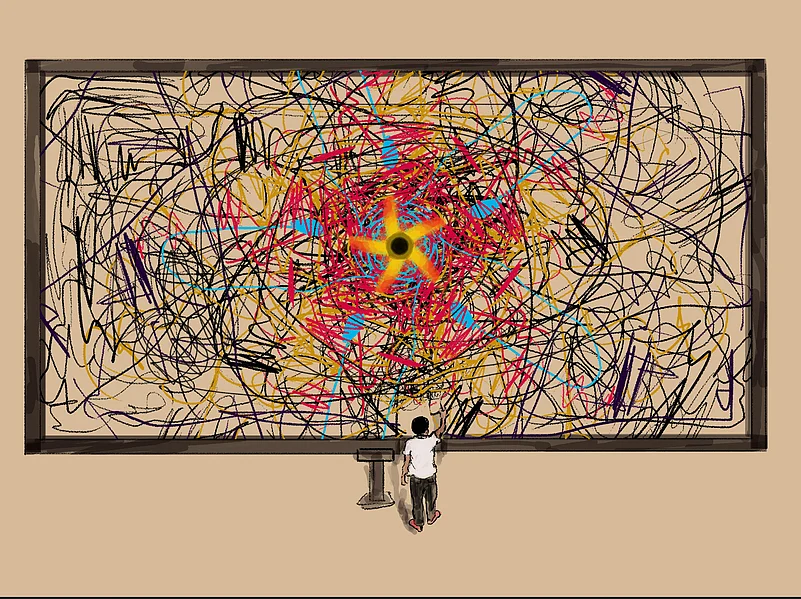How naive I was to consider artists as paragons of morality and equality! I once believed that true art comes from heart. Yet, how disheartening it was to witness people masterfully imitating art, only to discover their hearts brimming with venom and vitriol. The realisation that art can be wielded by the malevolent was a profound and pathetic revelation.
There are two types of deceivers in the art world. The first kind creates art that contradicts their own beliefs, crafting works that advocate for values they personally reject. They present a facade, fooling their audience into seeing them as virtuous. The second kind involves artists who, after creating works imbued with beauty and wisdom, switch off their artistic persona and return to promoting violence and hatred in their private lives. The philosophical problem with both types of deceivers is that they challenge our trust in art and artists.
It took me time and effort to grasp the reality that art isn't always a reflection of the artist. Sometimes, art is just art, created without noble motives. It doesn’t carry a deeper meaning beyond its immediate impact. It is often divorced from the virtue of its maker. Art is more about practice than it is about lofty ideals. It is a skill honed, a talent nurtured, and sometimes, that's all it is.
With a heavy heart, I acknowledge that a proficient photographer possesses the ability to discern beauty and adeptly capture it through their lens. A skilled writer possesses the knowledge of selecting daedal words to evoke specific emotions, while a talented painter masterfully manipulates color combinations, textures, and perspectives. However, these technical skills do not guarantee depth of character or upright ideologies; indeed, they can sometimes serve to conceal the true beliefs and values of the artist.
Impostors masquerading as artists not only distort the true essence of art but also tarnish the legacy of genuine creators. Their deceptive practices not only mislead the audience but also erode the integrity and authenticity that define the artistic lineage. Take, for instance, Van Gogh's swirling brushstrokes and vibrant colours that paint a canvas of his inner turmoil and the mesmerising beauty he found even in the darkest moments. Frida Kahlo's haunting self-portraits that depict her pain and resilience, each stroke capturing the raw emotion etched into her features. Basquiat's graffiti-inspired art that bursts with energy and symbolism, narrating the complexities of identity and social injustice through bold lines and enigmatic symbols. Sylvia Plath's poetry that is like a deep, dark forest, where each word is a twisting branch reaching into the depths of her mind, tangled emotions and the quest for self-understanding. The presence of the impersonators prompts us to scrutinise the work of artists we admire, examining whether their art embodies their essence or if it stands apart from their true being.
As I grew more accepting of the notion that people can manipulate art for their own agendas, I began to seek examples of artists whose brilliance lay solely in technical skill, rather than in righteous intent. To my dismay, I discovered numerous instances where artists were not just complicit with their silence but actively indulgent with their actions in the wrongdoings.
Throughout history, there have been several artists whose remarkable talents were overshadowed by their personal hatred and bigotry. Richard Wagner, the famous 19th-century composer whose operatic works remain influential, yet his anti-Semitic views have tarnished his legacy. The renowned poet Ezra Pound, known for his contributions to modernist literature, openly supported fascist regimes and espoused anti-Semitic rhetoric. The celebrated filmmaker Leni Riefenstahl created visually stunning and innovative propaganda films for the Nazi regime, her artistry inextricably linked to the promotion of hateful ideologies. These examples reinforce the unsettling reality that great artistic talent can coexist with deeply troubling beliefs. It seems more fitting to label these deceitful individuals as "Charlatan Crafters".
These instances and insights raise questions about the idealised nature of art. Do we place unreasonable demands on artists by expecting them to possess a well-functioning moral compass? Is it unjust to anticipate that art should be devoid of malicious intent? How far and long can an artist stray from their beliefs in their work? Is it acceptable for art to be derived from artifice? Should art merely entertain and not enrich?
While opinions may differ on the answers to these intriguing inquiries, there is something that everyone can consider as the bottom line: Good art moves us; great art moves us toward the moral end.
(Amit recently completed his B.Tech in Mechanical Engineering from the National Institute of Technology Karnataka. He received the United Nations Millennium Fellowship. His idea for Environmental Conservation was awarded by the Central Pollution Control Board.)

















